A Simulation Model for the Inductor of Electromagnetic Levitation Melting and Its Validation
Abstract
1. Introduction
1.1. Electromagnetic Levitation Melting
1.2. Aim of the Paper
- Temperature as a function of time,
- Batch position during levitation,
- Current frequency,
- Voltage,
- Current.
2. Materials and Methods
2.1. Measurement Station
- Thermal camera (infrared)-PI 640 (marked 1 in Figure 1). The manufacturer was Optris, and the production location was Germany.
- Video camera-D5300 (marked 2 in Figure 1). The manufacturer was Nikon, and the production location was Taiwan.
- Glass tube (marked 3 in Figure 1). The manufacturer and production location are unknown.
- Current probe with converter CWT 60xB (marked 4 in Figure 1). The manufacturer was Powertek, and the production location was the UK.
- Oscilloscope-THS720P Handheld Digital Oscilloscope. The manufacturer was Tektronix, and the production location was the USA.
- M—mutual inductance between the current-carrying conductor and the Rogowski coil,
- —the rate of change of the current in the conductor (derivative of the current over time).
2.2. Geometry and Current Parameters of the Batch and the Inductor
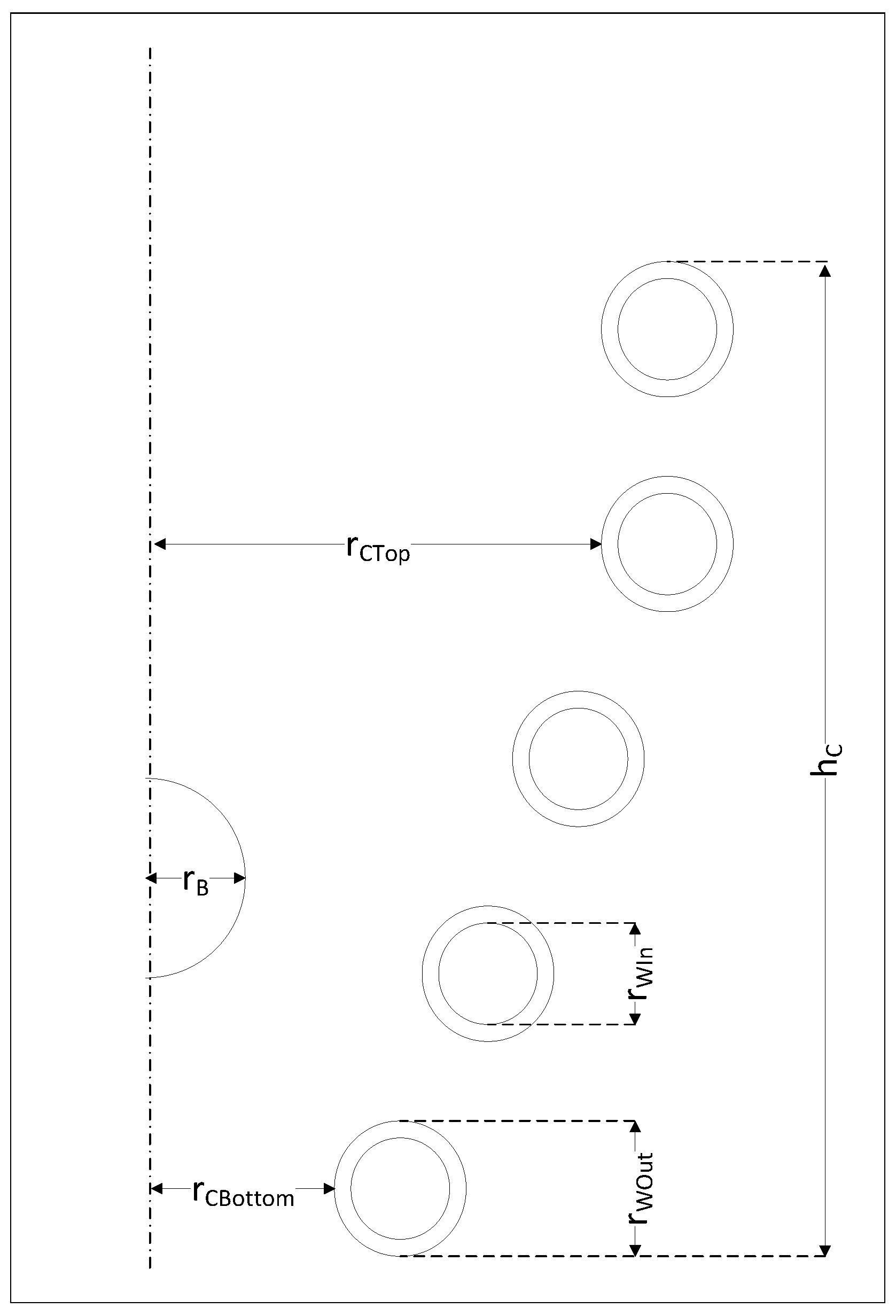
2.3. Software and Hardware
- SpaceClaim [52] is a CAD modeling tool that was used to prepare the geometry of the model. It supports a predefined geometry based on mathematical equations, such as a helix, which speeds up the modeling process. Moreover, there is also the possibility of recording models as Python scripts, which allowed us to make more precise and complex modifications to the geometry.
- Maxwell 3D [53] is a tool that allowed us to simulate the work of electric machines. The Maxwell interface is compatible with the ACIS modeling standard. It supports a common CAD format, including SpaceClaim. Maxwell supports an adaptive mesh generator based on a user-defined convergence level. In addition, the mesh can also be defined by the user. The Maxwell 3D allowed us to calculate the eddy-current effects, assign the current and voltage excitation and boundary conditions (such as the natural boundaries, zero-tangential H Field, Neumann boundaries, and others), conduct the parametric simulation, and many other items.
- Icepack [53] allows the simulation of heating and cooling of electronic and energetic devices. The temperature of the object can be imported from the simulation result of the other Ansys products or can be assigned directly. The basic solution type is steady state with transient calculations. It also supports temperature changes through convection, radiation, and conduction.
- Fluent [54] enabled us to calculate the flow of the fluid that had to be simulated in the convection. Fluent has a specific version for user groups with specific needs or constraints. The Fluent simulation can be coupled with other products.
2.4. Simulation Model
2.4.1. Flow of Simulation
- The batch was a solid sphere with a radius of 3 mm.
- The Z-axis was set at the center of the coil.
- The inductor in the model had two ends of the wire in the Y-direction, which corresponded to the wire connected to the power source in the physical inductor.
- In the Y-direction, the wire deformation was visible, which allowed us to change the coil direction of the last wire.
- In the modeled inductor, the distances between circumvolutions were maintained as the same, but in the physical inductor, they were slightly irregular.
2.4.2. Electromagnetic Field Analysis
- —angular frequency,
- —field penetration depth,
- —electric conductivity,
- —magnetic permeability.
- —source current density,
- —source current,
- S—surface,
- —magnetic vector potential,
- —imaginary unit,
- —angular frequency,
- —conductivity,
- —magnetic permeability,
- —electric potential.
2.4.3. Thermal Field Analysis
- k—thermal conductivity,
- T—temperature,
- q—volume density of the heat source,
- —mass density,
- c—specific heat capacity.
2.4.4. Fluid Dynamics
- —fluid density,
- —velocity vector,
- p—static pressure,
- g—gravitational acceleration,
- —molecular viscosity,
- I—unit tensor,
- —energy density,
- —effective conductivity consisting of the conductivity and the conductivity due to the turbulence.
- —effective viscosity,
- —dynamic viscosity,
- —turbulent viscosity,
- k—kinetic energy of turbulence,
- —turbulence energy dissipation coefficient,
- C—empirical constant.
3. Results
3.1. The Ascending Force
3.2. Batch Heating
3.3. Mesh Quality
3.4. Comparison with Other Models
4. Conclusions and Future Research
- The simulated melting time takes 86 s, which is 5 s faster than the median measured time.
- Batch levitation occurs at the 30 mm position, which is 2 mm lower compared to the measurements.
- We investigated the quality of the model by increasing the number of mesh elements and comparing the results. We state the solution quality as good.
- The computational time of the model is approximately 50 min, which is acceptable for future predictive uses.
Author Contributions
Funding
Institutional Review Board Statement
Informed Consent Statement
Data Availability Statement
Conflicts of Interest
Abbreviations
| Acronyms | Meaning |
| angular frequency | |
| bottom radius of the inductor | |
| conductivity | |
| DO | discrete ordinals |
| effective conductivity | |
| effective viscosity | |
| electric potential | |
| C | empirical constant |
| energy density | |
| field penetration depth | |
| g | gravitational acceleration |
| imaginary unit | |
| inner radius of the wire | |
| k | kinetic energy of turbulence |
| magnetic permeability | |
| magnetic vector potential | |
| mass density | |
| molecular viscosity | |
| outer radius of the wire | |
| RTE | radiation transfer equation |
| radius of the batch | |
| source current density | |
| source current | |
| c | specific heat capacity |
| p | static pressure |
| S | area |
| T | temperature |
| k | thermal conductivity |
| top radius of the inductor | |
| total height of the inductor | |
| turbulence energy dissipation coefficient | |
| turbulent viscosity | |
| I | unit tensor |
| velocity vector | |
| q | volume density of the heat source |
References
- Odette, R.; Zinkle, S. Chapter 13-Refractory Alloys: Vanadium, Niobium, Molybdenum, Tungsten. In Structural Alloys for Nuclear Energy Applications; Newnes: Oxford, UK, 2019. [Google Scholar]
- Martienssen, W.; Warlimont, H. Refractory Metals and Refractory Metal Alloys. In Springer Handbook of Condensed Matter and Materials Data; Springer: Berlin/Heidelberg, Germany, 2005; Volume 1. [Google Scholar]
- Hancock, D.; Homfray, D.; Porton, M.; Todd, I.; Wynne, B. Refractory metals as structural materials for fusion high heat flux components. J. Nucl. Mater. 2018, 512, 169–183. [Google Scholar] [CrossRef]
- Prasad, N.E.; Wanhill, R.J. Niobium and Other High Temperature Refractory Metals for Aerospace Applications. In Aerospace Materials and Material Technologies; Springer: Berlin/Heidelberg, Germany, 2017; Volume 1. [Google Scholar]
- Frommeyer, G.; Rablbauer, R. High temperature materials based on the intermetallic compound NiAl reinforced by refractory metals for advanced energy conversion technologies. Steel Res. Int. 2008, 79, 507–512. [Google Scholar] [CrossRef]
- El-Genk, M.S.; Tournier, J.M. A review of refractory metal alloys and mechanically alloyed-oxide dispersion strengthened steels for space nuclear power systems. J. Nucl. Mater. 2005, 340, 93–112. [Google Scholar] [CrossRef]
- Natarajan, S.; Gopalan, V.; Rajan, R.A.A.; Jen, C.P. Effect of rare earth metals (Y, La) and refractory metals (Mo, Ta, Re) to improve the mechanical properties of W–Ni–Fe Alloy—A Review. Materials 2021, 14, 1660. [Google Scholar] [CrossRef]
- Oh, J.M.; Roh, K.M.; Lim, J.W. Brief review of removal effect of hydrogen-plasma arc melting on refining of pure titanium and titanium alloys. Int. J. Hydrogen Energy 2016, 41, 23033–23041. [Google Scholar] [CrossRef]
- Sankar, M.; Prasad, V.S.; Baligidad, R.; Gokhale, A. Effect of vacuum arc remelting and processing parameters on structure and properties of high purity niobium. Int. J. Refract. Met. Hard Mater. 2015, 50, 120–125. [Google Scholar] [CrossRef]
- Takeda, O.; Okabe, T.H. Current status of titanium recycling and related technologies. JOM 2019, 71, 1981–1990. [Google Scholar] [CrossRef]
- Hou, D.; Jiang, Z.; Dong, Y.; Cao, Y.; Cao, H.; Gong, W. Thermodynamic design of electroslag remelting slag for high titanium and low aluminium stainless steel based on IMCT. Ironmak. Steelmak. 2016, 43, 517–525. [Google Scholar] [CrossRef]
- Elanski, D.; Mimura, K.; Ito, T.; Isshiki, M. Purification of tantalum by means of hydrogen plasma arc melting. Mater. Lett. 1997, 30, 1–5. [Google Scholar] [CrossRef]
- Vutova, K.; Vassileva, V.; Stefanova, V.; Amalnerkar, D.; Tanaka, T. Effect of electron beam method on processing of titanium technogenic material. Metals 2019, 9, 683. [Google Scholar] [CrossRef]
- Choudhury, A.; Hengsberger, E. Electron beam melting and refining of metals and alloys. ISIJ Int. 1992, 32, 673–681. [Google Scholar] [CrossRef]
- Nemkov, V.; Goldstein, R.; Kreter, K.; Jackowski, J. Modeling and optimization of cold crucible furnaces for melting metals. In Proceedings of the International Symposium Heating by Electromagnetic Sources, Padua, Italy, 21–24 May 2013. [Google Scholar]
- Morita, A.; Fukui, H.; Tadano, H.; Hayashi, S.; Hasegawa, J.; Niinomi, M. Alloying titanium and tantalum by cold crucible levitation melting (CCLM) furnace. Mater. Sci. Eng. A 2000, 280, 208–213. [Google Scholar] [CrossRef]
- Fashu, S.; Lototskyy, M.; Davids, M.W.; Pickering, L.; Linkov, V.; Tai, S.; Renheng, T.; Fangming, X.; Fursikov, P.V.; Tarasov, B.P. A review on crucibles for induction melting of titanium alloys. Mater. Des. 2020, 186, 108295. [Google Scholar] [CrossRef]
- Piao, R.; Yang, S.; Ma, L.; Wang, T. Vacuum Electromagnetic Levitation Melting of Ti–Al Based Alloy Prepared by Aluminothermic Reduction of Acid Soluble Ti Bearing Slag. Met. Mater. Int. 2020, 26, 130–142. [Google Scholar] [CrossRef]
- Spitans, S.; Franz, H.; Baake, E.; Jakovics, A. Large-scale levitation melting and casting of titanium alloys. Magnetohydrodynamics 2017, 53, 633–642. [Google Scholar] [CrossRef]
- Zhou, Y.; Zeng, W.; Yu, H. An investigation of a new near-beta forging process for titanium alloys and its application in aviation components. Mater. Sci. Eng. A 2005, 393, 204–212. [Google Scholar] [CrossRef]
- Zhi-shou, Z. Recent research and development of titanium alloys for aviation application in China. J. Aeronaut. Mater. 2014, 34, 44–50. [Google Scholar]
- Niinomi, M. Recent metallic materials for biomedical applications. Metall. Mater. Trans. A 2002, 33, 477–486. [Google Scholar] [CrossRef]
- Gao, L.; Shi, Z.; Li, D.; Zhang, G.; Yang, Y.; Mclean, A.; Chattopadhyay, K. Applications of electromagnetic levitation and development of mathematical models: A review of the last 15 years (2000 to 2015). Metall. Mater. Trans. B 2016, 47, 537–547. [Google Scholar] [CrossRef]
- Fukuda, M.; Hasegawa, A.; Nogami, S. Thermal properties of pure tungsten and its alloys for fusion applications. Fusion Eng. Des. 2018, 132, 1–6. [Google Scholar] [CrossRef]
- Ron, T.; Leon, A.; Popov, V.; Strokin, E.; Eliezer, D.; Shirizly, A.; Aghion, E. Synthesis of refractory high-entropy alloy WTaMoNbV by powder bed fusion process using mixed elemental alloying powder. Materials 2022, 15, 4043. [Google Scholar] [CrossRef]
- Atwood, R.; Lee, P.; Minisandram, R.; Jones, R. Multiscale modelling of microstructure formation during vacuum arc remelting of titanium 6-4. J. Mater. Sci. 2004, 39, 7193–7197. [Google Scholar] [CrossRef]
- Roy, A.; Bojarevics, V.; Pericleous, K. Multi-Physics Modeling in the Electromagnetic Levitation and Melting of Reactive Metals; CMS, University of Greenwich: London, UK, 2011. [Google Scholar]
- Przylucki, R.; Golak, S. The Stress Effects Occurring during Induction Heating of Titanium. Solid State Phenom. 2014, 211, 149–154. [Google Scholar] [CrossRef]
- Williams, J.C.; Boyer, R.R. Opportunities and issues in the application of titanium alloys for aerospace components. Metals 2020, 10, 705. [Google Scholar] [CrossRef]
- Yang, J.; Wang, H.; Wu, Y.; Wang, X.; Hu, R. A Combined Electromagnetic Levitation Melting, Counter-Gravity Casting, and Mold Preheating Furnace for Producing TiAl Alloy. Adv. Eng. Mater. 2018, 20, 1700526. [Google Scholar] [CrossRef]
- Palacz, M.; Melka, B.; Wecki, B.; Siwiec, G.; Przylucki, R.; Bulinski, P.; Golak, S.; Blacha, L.; Smolka, J. Experimental analysis of the aluminium melting process in industrial cold crucible furnaces. Met. Mater. Int. 2020, 26, 695–707. [Google Scholar] [CrossRef]
- Cui, C.; Hu, B.; Zhao, L.; Liu, S. Titanium alloy production technology, market prospects and industry development. Mater. Des. 2011, 32, 1684–1691. [Google Scholar] [CrossRef]
- Buliński, P.; Smolka, J.; Siwiec, G.; Blacha, L.; Golak, S.; Przyłucki, R.; Palacz, M.; Melka, B. Numerical examination of the evaporation process within a vacuum induction furnace with a comparison to experimental results. Appl. Therm. Eng. 2019, 150, 348–358. [Google Scholar] [CrossRef]
- Boikov, A.; Payor, V. The present issues of control automation for levitation metal melting. Symmetry 2022, 14, 1968. [Google Scholar] [CrossRef]
- Bakhtiyarov, S.I.; Siginer, D.A. Electromagnetic levitation part I: Theoretical and experimental considerations. Fluid Dyn. Mater. Process 2008, 4, 99–112. [Google Scholar]
- Toropova, L.V.; Alexandrov, D.V.; Kao, A.; Rettenmayr, M.; Galenko, P.K. Electromagnetic levitation method as a containerless experimental technique. Physics–Uspekhi 2022, 65. [Google Scholar] [CrossRef]
- Chan, G.C.Y.; Hieftje, G.M. Local cooling, plasma reheating and thermal pinching induced by single aerosol droplets injected into an inductively coupled plasma. Spectrochim. Acta Part B At. Spectrosc. 2016, 121, 55–66. [Google Scholar] [CrossRef]
- Sassonker, I.; Kuperman, A. Envelope dynamics of resonant inverter driven electromagnetic levitation melting system with experimental verification. Mech. Syst. Signal Process. 2020, 140, 106704. [Google Scholar] [CrossRef]
- Hectors, D.; Van Reusel, K.; Driesen, J. Validation of electromagnetic-thermal coupled modelling of levitation melting. In Proceedings of the 2008 IET 7th International Conference on Computation in Electromagnetics, IET, Brighton, UK, 7–10 April 2008; pp. 148–149. [Google Scholar]
- Hectors, D.; Van Reusel, K.; Driesen, J. Experimental validation of electromagnetic-thermal coupled modelling of levitation melting. Prz. Elektrotechniczny 2008, 84, 140–143. [Google Scholar]
- Spitans, S.; Baake, E.; Nacke, B.; Jakovičs, A. New technology for large scale electromagnetic levitation melting of metals. Magnetohydrodynamics 2015, 51, 121–132. [Google Scholar] [CrossRef]
- Spitans, S.; Baake, E.; Jakovics, A.; Franz, H. Numerical and experimental investigations of a large scale electromagnetic levitation melting of metals. In Proceedings of the 10-th PAMIR International Conference—Fundamental and Applied MHD, Cagliari, Italy, 20–24 June 2016. [Google Scholar]
- Nycz, B.; Malinski, L.; Przylucki, R. Influence of Selected Model Parameters on the Electromagnetic Levitation Melting Efficiency. Appl. Sci. 2021, 11, 3827. [Google Scholar] [CrossRef]
- Sassonker, I.; Kuperman, A. Electro-mechanical modeling of electromagnetic levitation melting system driven by a series resonant inverter with experimental validation. Energy Convers. Manag. 2020, 208, 112578. [Google Scholar] [CrossRef]
- Kermanpur, A.; Jafari, M.; Vaghayenegar, M. Electromagnetic-thermal coupled simulation of levitation melting of metals. J. Mater. Process. Technol. 2011, 211, 222–229. [Google Scholar] [CrossRef]
- Royer, Z.L. Optimizing Electromagnetic Levitation Design to Enhance Thermodynamic Measurement. Ph.D. Thesis, Iowa State University, Ames, IA, USA, 2012. [Google Scholar]
- Royer, Z.L.; Tackes, C.; LeSar, R.; Napolitano, R.E. Coil optimization for electromagnetic levitation using a genetic like algorithm. J. Appl. Phys. 2013, 113, 214901. [Google Scholar] [CrossRef]
- Yadav, S.; Verma, S.; Nagar, S. Performance enhancement of magnetic levitation system using teaching learning based optimization. Alex. Eng. J. 2017, 57, 2427–2433. [Google Scholar] [CrossRef]
- Orosz, T.; Pánek, D.; Kuczmann, M. Performance analysis of a robust design optimization of a solenoid with different sensitivity metrics. J. Comput. Appl. Math. 2023, 424, 115021. [Google Scholar] [CrossRef]
- Di Barba, P.; Dughiero, F.; Forzan, M.; Lowther, D.A.; Mognaschi, M.E.; Sieni, E.; Sykulski, J.K. A benchmark TEAM problem for multi-objective Pareto optimization in magnetics: The time-harmonic regime. IEEE Trans. Magn. 2019, 56, 1–4. [Google Scholar] [CrossRef]
- Wen, C.D.; Mudawar, I. Emissivity characteristics of polished aluminum alloy surfaces and assessment of multispectral radiation thermometry (MRT) emissivity models. Int. J. Heat Mass Transf. 2005, 48, 1316–1329. [Google Scholar] [CrossRef]
- Ansys®. SpaceClaim, Release 20.2; Ansys: Canonsburg, PA, USA, 2020.
- Ansys®. Electromagnetics Suite, Release 20.2; Ansys: Canonsburg, PA, USA, 2022.
- Ansys®. Fluent, Release 20.2; Ansys: Canonsburg, PA, USA, 2020.
- Ansys®. Icepack, Release 20.2. Icepak Help, Specifying Solution Settings. Ansys: Canonsburg, PA, USA, 2020.
- Ostrowski, P.; Sprawka, P.; Krysowaty, I. Analiza dynamiki wsadu podczas topienia indukcyjnego w warunkach lewitacji. TTS Tech. Transp. Szyn. 2016, 23, 479–483. [Google Scholar]
- Witteveen, J.; van Gastel, R.; van Houselt, A.; Zandvliet, H. 3D modeling of electromagnetic levitation coils. Curr. Appl. Phys. 2021, 32, 45–49. [Google Scholar] [CrossRef]
- Hyers, R.W. Fluid flow effects in levitated droplets. Meas. Sci. Technol. 2005, 16, 394. [Google Scholar] [CrossRef]
- Bullard, C.; Hyers, R.W.; Abedian, B. Spin-up instability of a levitated molten drop in magnetohydrodynamic-flow transition to turbulence. IEEE Trans. Magn. 2005, 41, 2230–2235. [Google Scholar] [CrossRef]
- Lee, J.; Matson, D.M.; Binder, S.; Kolbe, M.; Herlach, D.; Hyers, R.W. Magnetohydrodynamic modeling and experimental validation of convection inside electromagnetically levitated Co-Cu droplets. Metall. Mater. Trans. B 2014, 45, 1018–1023. [Google Scholar] [CrossRef]
- Bojarevics, V.; Hyers, R.W. Levitated liquid dynamics in reduced gravity and gravity-compensating magnetic fields. JOM 2012, 64, 1089–1096. [Google Scholar] [CrossRef]
- Spitans, S.; Jakovičs, A.; Baake, E.; Nacke, B. Numerical modelling of free surface dynamics of melt in an alternate electromagnetic field. Magnetohydrodynamics 2011, 47, 385–397. [Google Scholar]
- Spitans, S.; Jakovics, A.; Baake, E.; Nacke, B. Numerical Modeling of Free Surface Dynamics of Melt in an Alternate Electromagnetic Field: Part I. Implementation and Verification of Model. Metall. Mater. Trans. B 2013, 44, 593–605. [Google Scholar] [CrossRef]
- Feng, L.; Shi, W.Y. The influence of eddy effect of coils on flow and temperature fields of molten droplet in electromagnetic levitation device. Metall. Mater. Trans. B 2015, 46, 1895–1901. [Google Scholar] [CrossRef]
- Tourret, D.; Gandin, C.A. A generalized segregation model for concurrent dendritic, peritectic and eutectic solidification. Acta Mater. 2009, 57, 2066–2079. [Google Scholar] [CrossRef]
- Tourret, D.; Reinhart, G.; Gandin, C.A.; Iles, G.; Dahlborg, U.; Calvo-Dahlborg, M.; Bao, C. Gas atomization of Al–Ni powders: Solidification modeling and neutron diffraction analysis. Acta Mater. 2011, 59, 6658–6669. [Google Scholar] [CrossRef]
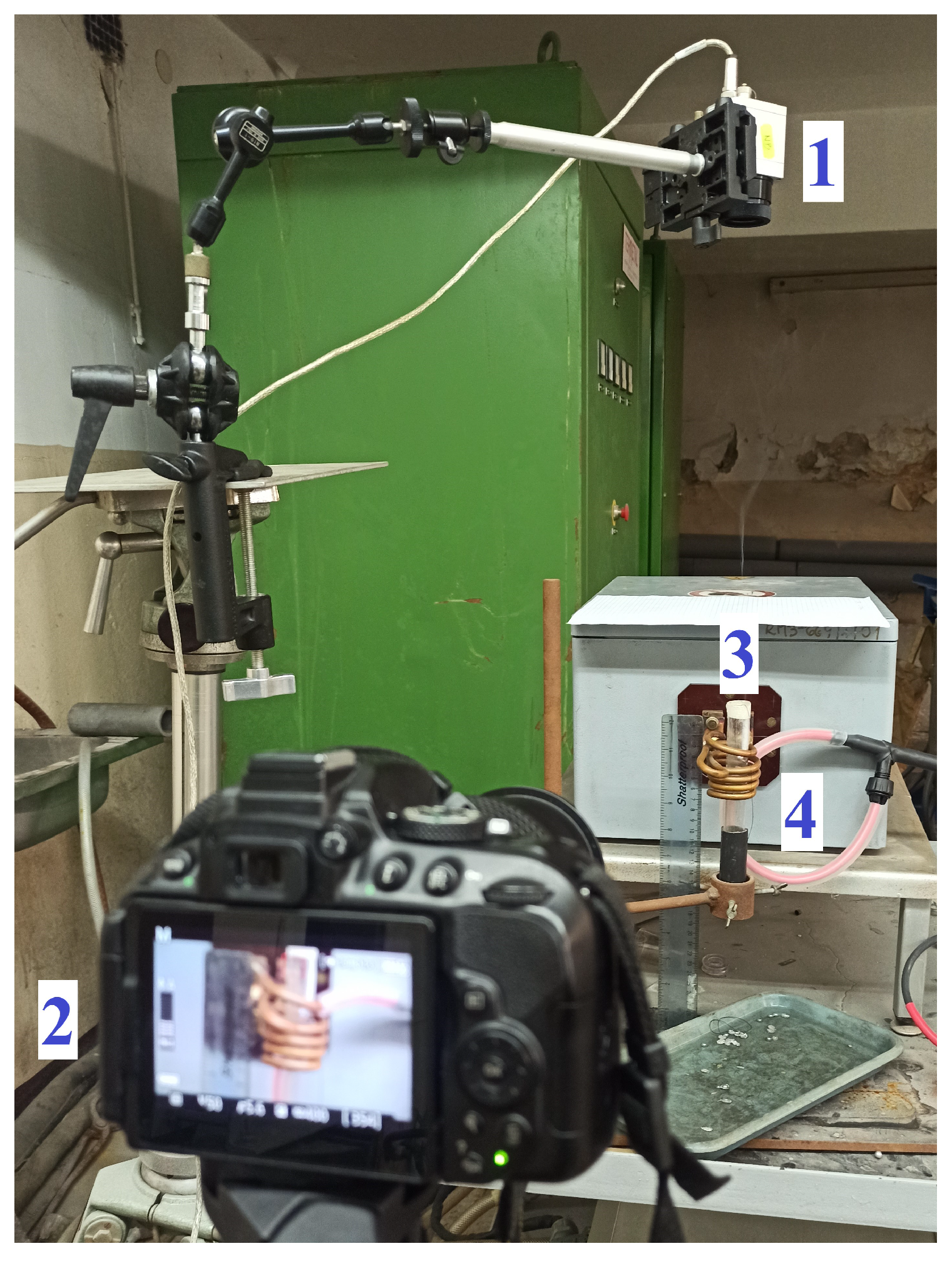
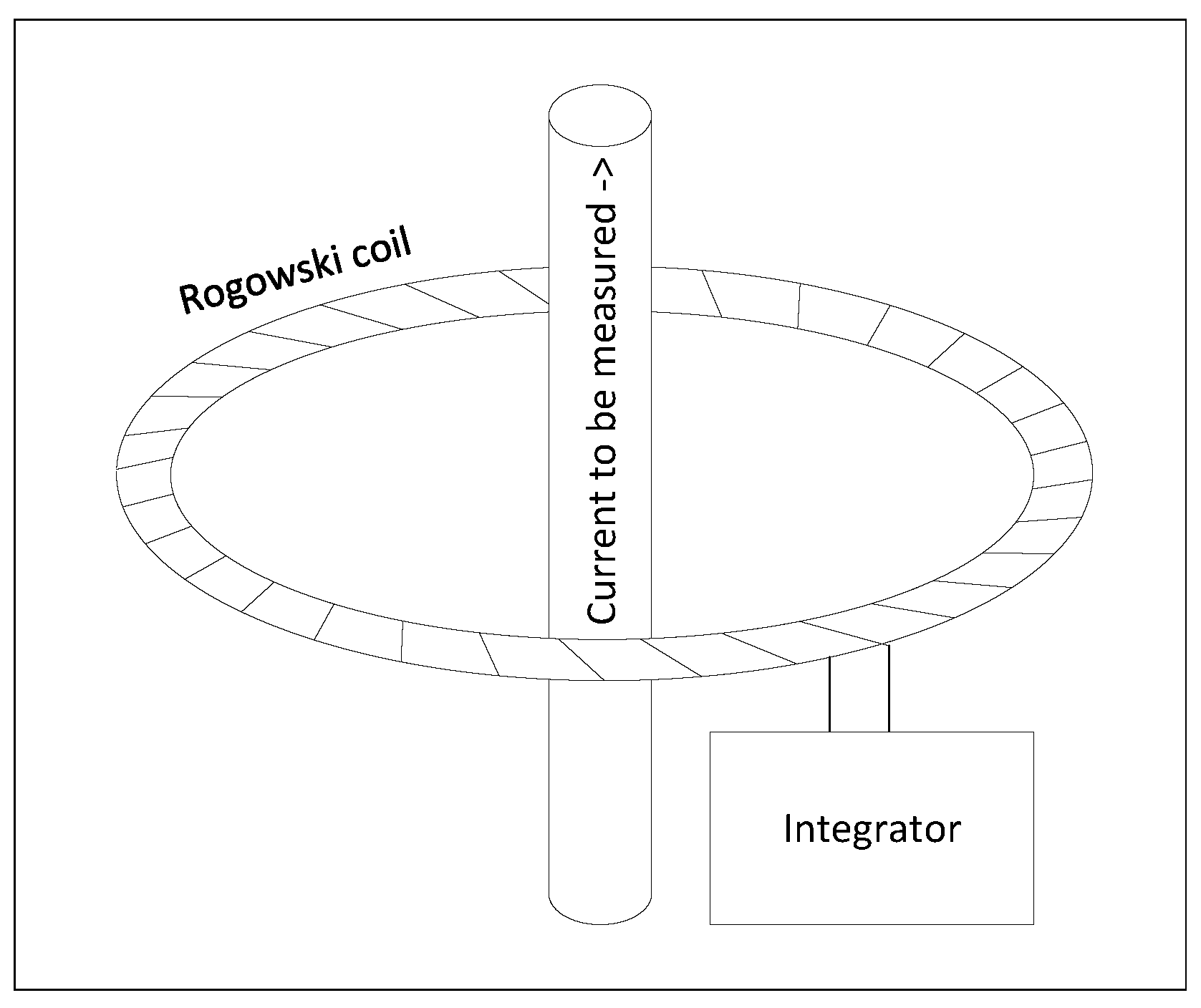
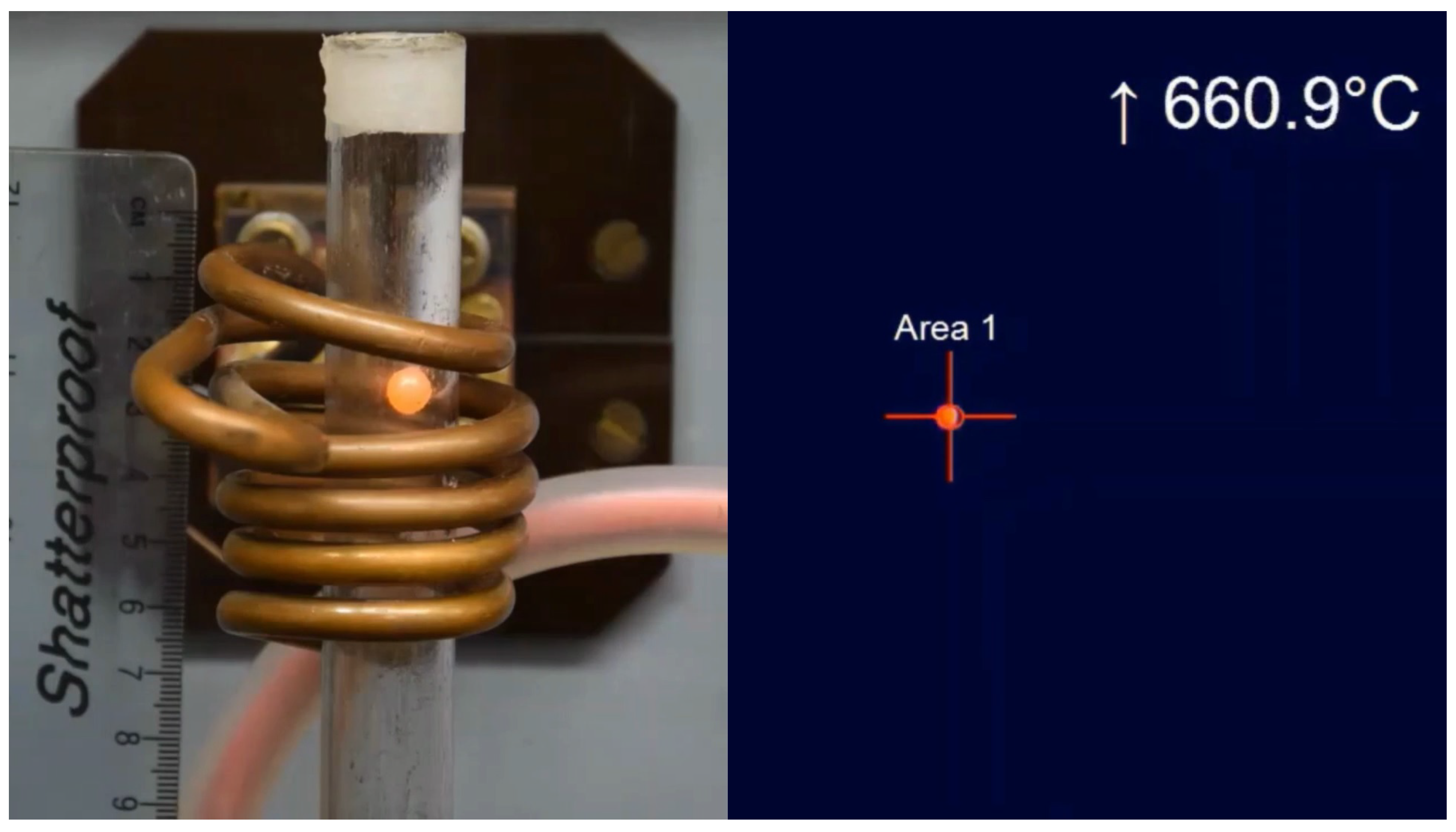

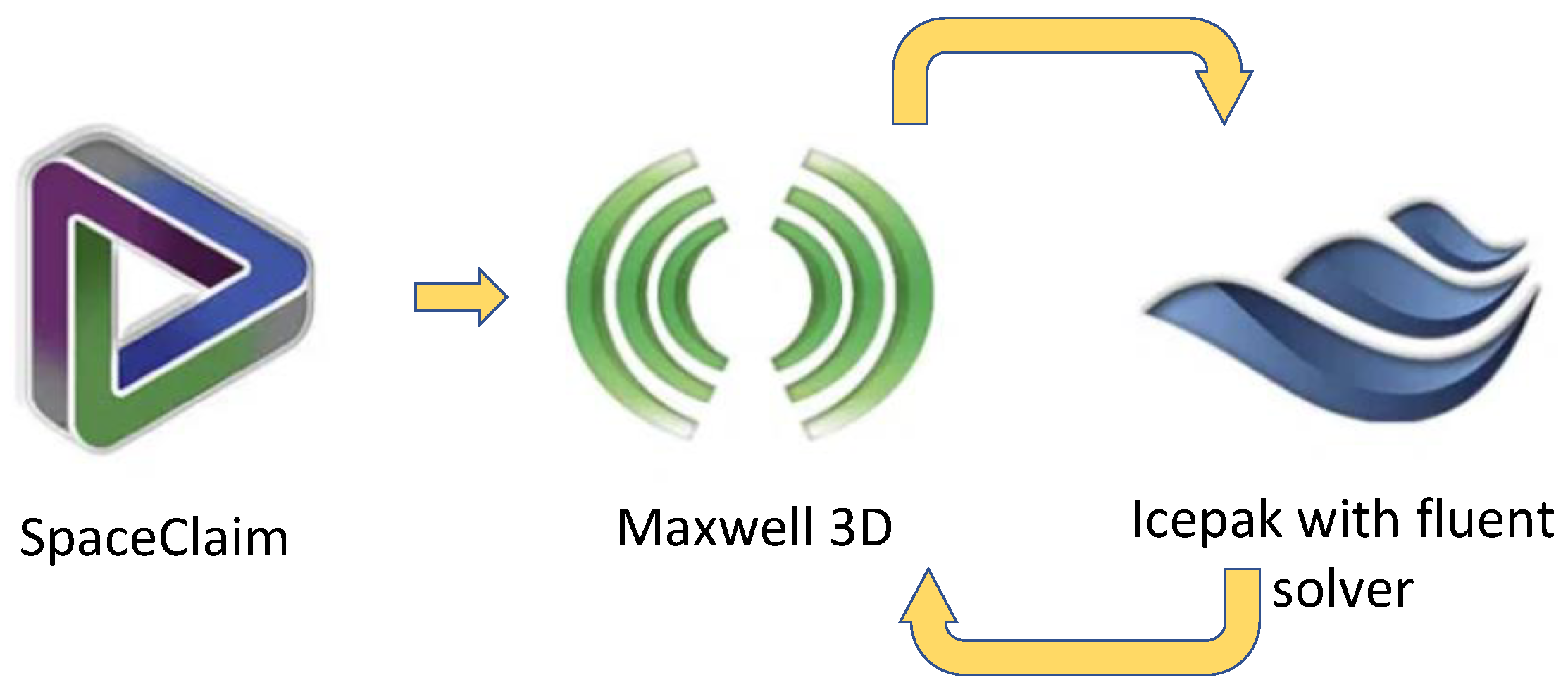
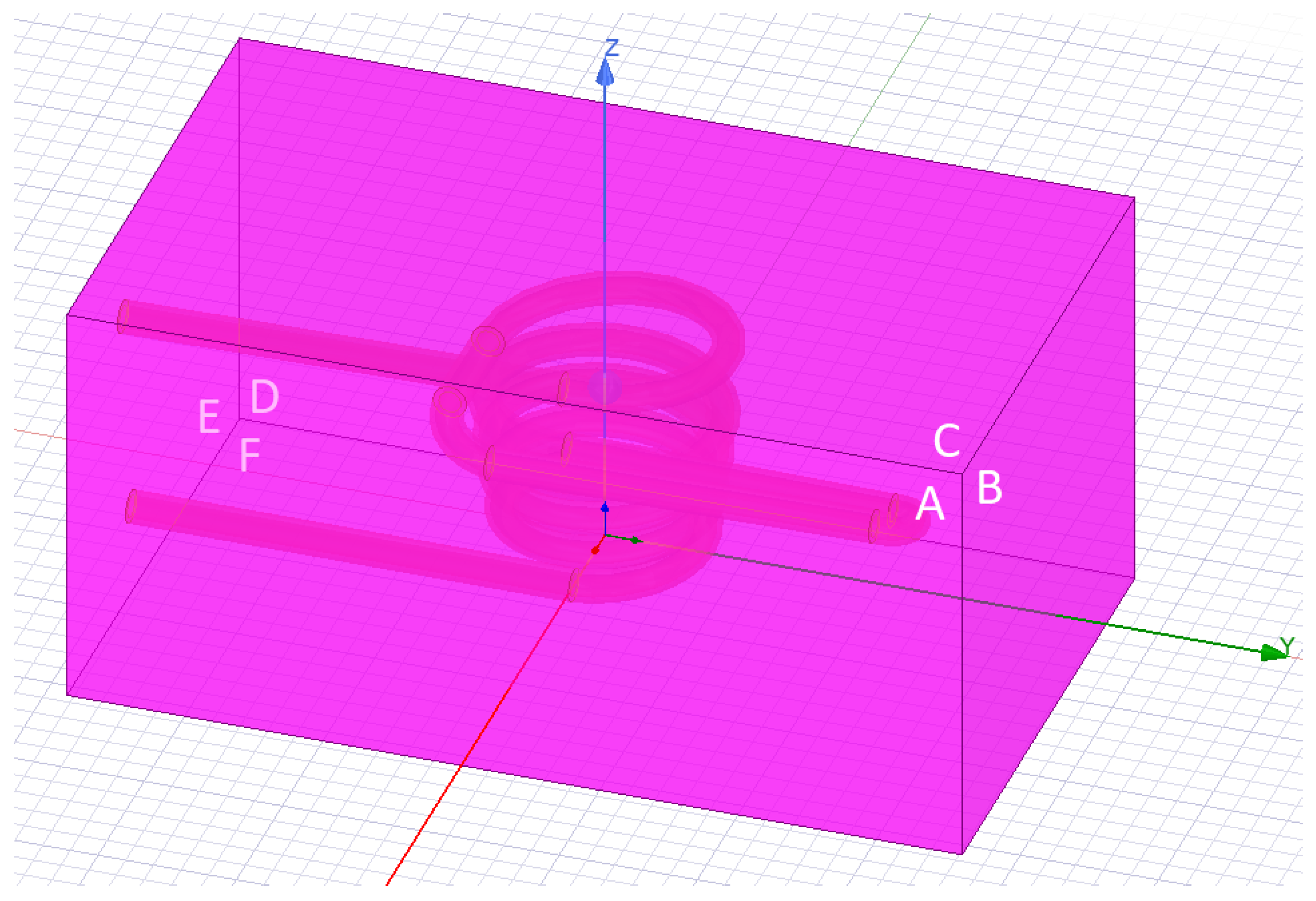
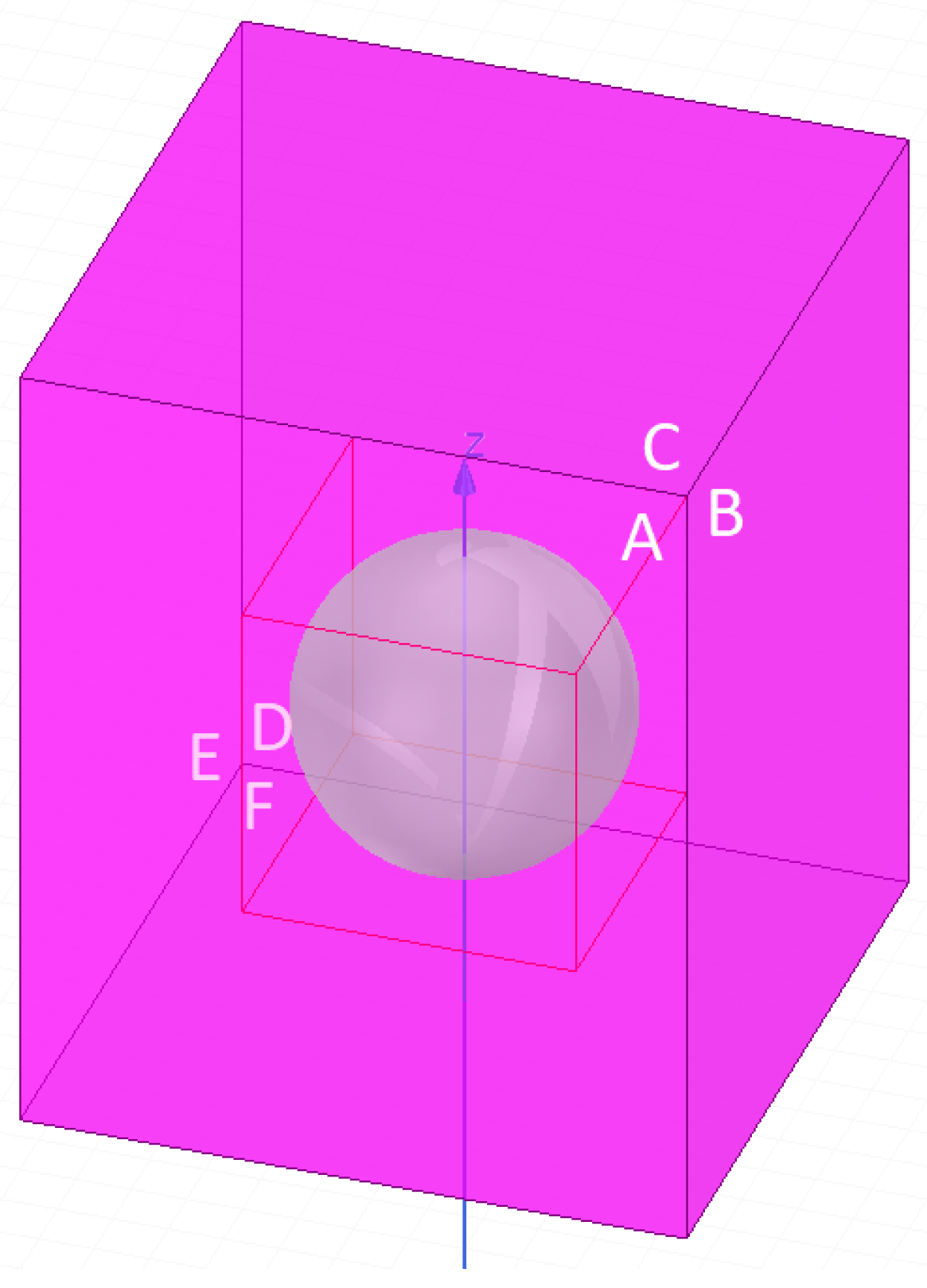



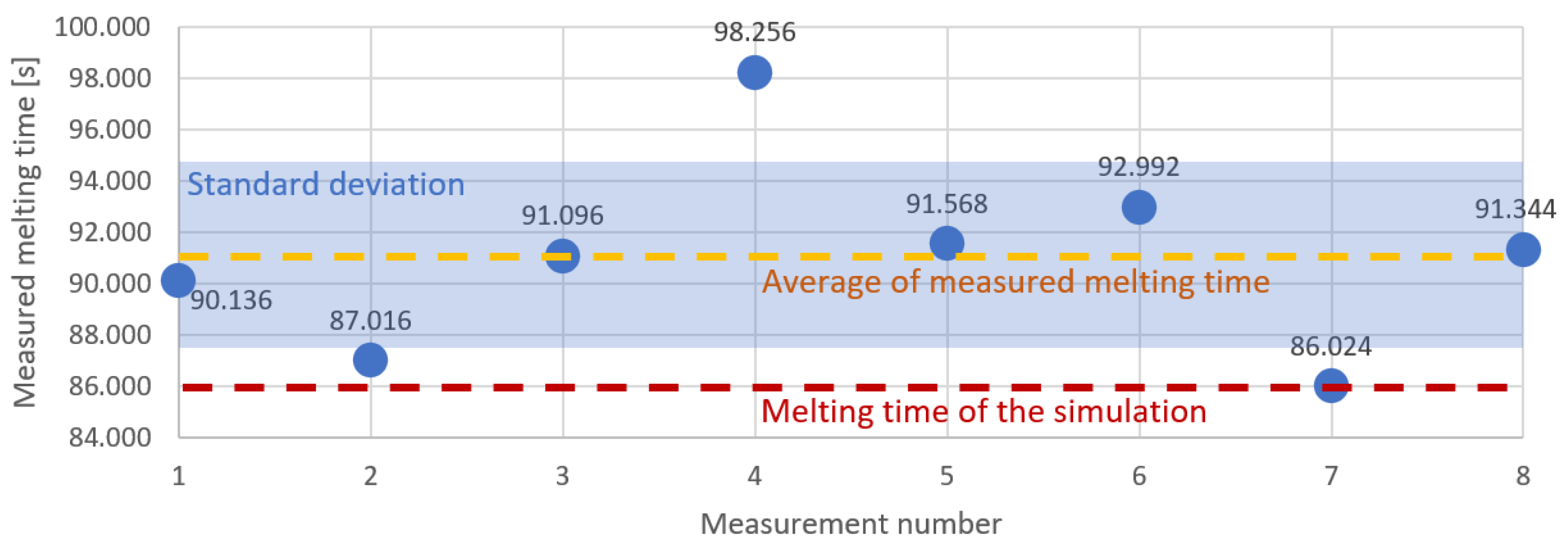




| Symbol | Meaning | Value [mm] |
|---|---|---|
| The inner radius of the wire | 2 | |
| The outer radius of the wire | 3 | |
| The bottom radius of the inductor | 14 | |
| The top radius of the inductor | 18 | |
| The total height of the inductor | 40 |
| Supply Parameter | Value |
|---|---|
| Current | 340 A |
| Voltage | 520 V |
| Phase shift of current and voltage | |
| Current frequency | Hz |
| Model Source | Model Is Asymmetrical | Verification Method | Interaction with Surroundings | Material Property Actualized with Temperature Change |
|---|---|---|---|---|
| Nycz et al. (2021) [43] | Yes | Not verified | No interaction | No |
| Witteveen et al. (2021) [57] | Yes | By other model | No interaction | No |
| Royer et al. (2013) [47] | No | Not verified | Convection and radiation | No |
| Kermanpur et al. (2011) [45] | No | By experiment | No interaction | Yes |
| Sassonker and Kuperman (2020) [44] | No | By experiment | No interaction | No |
| Current paper | Yes | By experiment | Convection and radiation | Yes |
Disclaimer/Publisher’s Note: The statements, opinions and data contained in all publications are solely those of the individual author(s) and contributor(s) and not of MDPI and/or the editor(s). MDPI and/or the editor(s) disclaim responsibility for any injury to people or property resulting from any ideas, methods, instructions or products referred to in the content. |
© 2023 by the authors. Licensee MDPI, Basel, Switzerland. This article is an open access article distributed under the terms and conditions of the Creative Commons Attribution (CC BY) license (https://creativecommons.org/licenses/by/4.0/).
Share and Cite
Nycz, B.; Przyłucki, R.; Maliński, Ł.; Golak, S. A Simulation Model for the Inductor of Electromagnetic Levitation Melting and Its Validation. Materials 2023, 16, 4634. https://doi.org/10.3390/ma16134634
Nycz B, Przyłucki R, Maliński Ł, Golak S. A Simulation Model for the Inductor of Electromagnetic Levitation Melting and Its Validation. Materials. 2023; 16(13):4634. https://doi.org/10.3390/ma16134634
Chicago/Turabian StyleNycz, Błażej, Roman Przyłucki, Łukasz Maliński, and Sławomir Golak. 2023. "A Simulation Model for the Inductor of Electromagnetic Levitation Melting and Its Validation" Materials 16, no. 13: 4634. https://doi.org/10.3390/ma16134634
APA StyleNycz, B., Przyłucki, R., Maliński, Ł., & Golak, S. (2023). A Simulation Model for the Inductor of Electromagnetic Levitation Melting and Its Validation. Materials, 16(13), 4634. https://doi.org/10.3390/ma16134634







